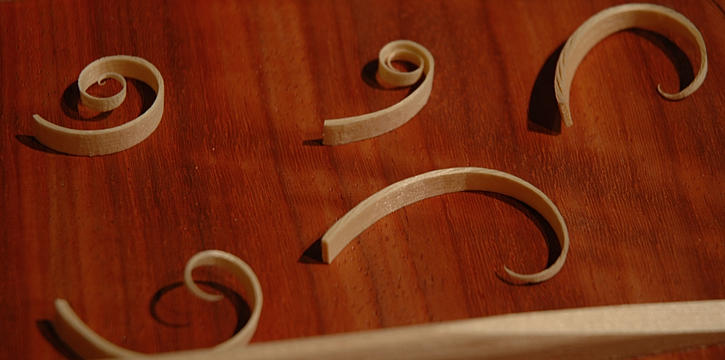Hello, great to back, here is a new video of a luthier Kipp Krusa, the video shows the birth of a guitar from beginning to end as if it all happens in one day, well done, very nice space for the workshop, well organized tools, wall racks and wall tool panels, I like this workshop,
http://www.krusaguitars.com/
Kipp's site has a great fetcher, it lists and explains the various materials and woods that can be used to build your guitar, with some stunning pictures of the woods, this is really helpful for those are not sure of what they want in their guitar.
from Kruse's web site Musings section:
Guitar building is meticulous work and a clean workbench is essential. Every step of the process however, creates its own mess - either shavings, chips or dust. As a result of this my shop goes back and forth between meticulous and chaotic several times a day.
I work for a period of time, and I examine the shavings as they are cast off of the tools. Then I brush them off the workbench, sweep them up from the floor and move on to the next step in the process. Although they are a nuisance, it is important to study these little artifacts and to maintain awareness of the lessons that can be learned from having done so.
A wood shaving will tell me about the state of the tool that produced it, but also about the manner in which I have used the tool.
Assuming that the material being planed is flat to begin with, a well sharpened and true hand plane will produce a shaving that is the length of the stroke that produced it. Such a shaving should be an even thickness throughout its length. I occasionally measure a shaving's thickness with a digital caliper. My goal in doing this is to check for constancy. These shavings are often only .001 of an inch. It is more common for me to slide a shaving through my fingers and view its transparency in front of a light. If I 'm not satisfied with what I have either measured or seen I immediately blame the tool, usually with language that spirals downward.
After addressing the tool's edge, I am often forced to turn my attention to another component in the equation - myself. Although this is harder, it can be more rewarding than the experience of sharpening a beloved tool. True craftsmanship demands self awareness and self discipline from moment to moment. The building of a fine instrument requires a sustained attention to all of the tangible variables inherent in the process. Realizing that I am one of those variables has been one of my most resonant lessons. In the shop I have to let go of whatever may hinder my ability to do my best work. Each pass of the tool is a little personal test, one that requires me to accept and to resolve even the smallest of issues as they arise. It is a little like therapy when "What did that shaving look like?" translates into "How are you doing, right now? Are you focused on what you are doing?"
Townes Van Zandt said, "I don't think you can ever do your best. Doing your best is a process of trying to do your best." Thank you Townes, if for nothing else, for trying!
The shavings that affect me the most are produced by a chisel as I taper the ends of braces. These shavings exhibit an evenly spaced series of fractures that create a lovely spiraling curl. I pay attention to each of these as they are produced. They let me know whether or not the angle of my chisel is consistent with it's previous pass. They also remind me that life's most beautiful gifts often come in the form of small things. These spiraling shavings illustrate to me that my work is, in some mystical way, guided by the structural and physical laws of the universe. The spiral is one of the natural fundamental determinants of the form and structure of living organisms. Botanically, spirals are often defined as whorls. I just love this word, "whorls" - almost worlds; and such a beautiful sounding word for the shavings that are created on my workbench. Whorls...

No comments:
Post a Comment